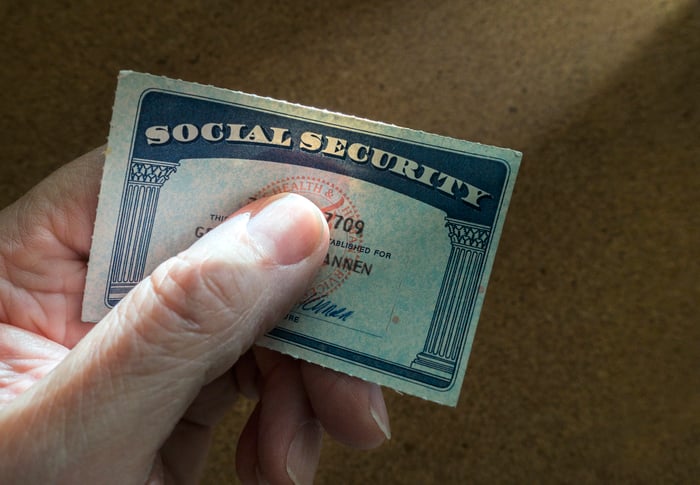For many of Social Security's more than 53 million retired-worker beneficiaries, their monthly payout represents a financial foundation. Even though the average monthly retired-worker benefit of $2,008.31, as of August, is a relatively modest sum, it's helped slash the senior poverty rate and is relied on by 80% to 90% of retirees each month to cover some portion of their expenses.
But this program, which has been doling out traditional benefits to retired workers, workers with disabilities, and survivors of deceased workers, for decades, is adjusted often. Changes are implemented and announced on a near-annual basis by the Social Security Administration (SSA).
However, the SSA isn't the only entity capable of altering Social Security. Courtesy of President Donald Trump, via an executive order (EO) signed in March, Social Security officially changes forever today, Sept. 30.

President Trump signing a bill. Image source: Official White House Photo by Shealah Craighead, courtesy of the National Archives.
Donald Trump is ending an 85-year practice for Social Security, effective today
The EO in question ("Modernizing Payments To and From America's Bank Account") was signed by President Trump on March 25 and serves one purpose: to end the issuance of paper checks by the federal government on Sept. 30 (the official compliance date of the EO). This applies to Social Security, which has been parsing out paper checks since January 1940, as well as other federal programs.
On one hand, this permanent change is only going to impact a very small percentage of the more than 70 million people currently receiving a traditional Social Security payout. Digital payments, such as direct deposit, began in 1975 for Social Security, with more than 99% of beneficiaries receiving some form of electronic fund transfer (EFT) in 2025.
On the other hand, it means the more than 390,800 beneficiaries (approximately 0.6% of existing beneficiaries) still receiving a paper check, as of September 2025, per the SSA, will need to take action to continue receiving their monthly Social Security income.
The "why?" behind this move has everything to do with Donald Trump's ongoing efforts to reduce perceived fraud and wasteful spending in Washington, D.C. In particular, transitioning to EFTs offers three defined advantages:
- It gets benefits into the hands of recipients much faster than paper checks. Whereas snail mail can take a week or longer to arrive, EFTs clear much faster.
- According to the president's EO, paper checks issued by the federal government are 16 times more likely to be lost or stolen than an EFT.
- Most important, there's a cost advantage in shifting to digital payments. While a paper check costs the federal government around $0.50 to issue, an EFT runs Uncle Sam less than $0.15 per payment. With more than 500,000 beneficiaries receiving a paper check earlier this year, a shift to digital payments will save Social Security over $2 million per year.
With exceptions for emergency situations and those folks without access to digital payment systems, two options to receive ongoing payments exist.
The easiest option would be to enroll in direct deposit if you have an account with a bank or credit union. Setting up direct deposit can be done in-person at a Social Security office, or online via a "my Social Security" account that has two-factor authentication. You can also request that your bank send your direct deposit information to the SSA using the automated enrollment process.
The second solution for those without a traditional bank or credit union account would be to use a Direct Express card. This is a prepaid debit card that can accept deposits from the federal government.

Image source: Getty Images.
A host of big changes are expected three months from now
In addition to Donald Trump permanently altering the Social Security program with his EO, as well as implementing a number of indirect adjustments since his January inauguration, the SSA is likely to announce a host of changes on Oct. 15 that'll kick in on Jan. 1, 2026.
The most-anticipated change that all 70 million-plus beneficiaries are awaiting is the annual cost-of-living adjustment (COLA), which is effectively the near-annual "raise" that accounts for the rising costs (inflation) recipients contend with. Independent estimates from nonpartisan senior advocacy group The Senior Citizens League and Social Security and Medicare policy analyst Mary Johnson peg Social Security's 2026 COLA at 2.7% and 2.8%, respectively.
If either of these forecasts proves accurate, it would mark the fifth consecutive year where COLAs topped 2.5%, which is a feat last accomplished between 1988 and 1997. However, a projected 11.5% increase in the monthly Medicare Part B premium, coupled with stubbornly high shelter and medical care services inflation, are likely to put a sizable dent in next year's cost-of-living adjustment for most aged beneficiaries.
Big changes are also expected for high-earning workers, as well as beneficiaries receiving the maximum monthly payout at full retirement age.
In years where a positive COLA is passed along and the National Average Wage Index increases, the maximum taxable earnings cap associated with the payroll tax climbs. In 2025, all earned income (wages and salary, but not investment income) from $0.01 to $176,100 is subject to the 12.4% payroll tax, which is the primary funding mechanism of Social Security. This taxable earnings cap (the $176,100 figure) should increase in 2026, which means high earners will be required to pay a bit more in payroll tax.
At the same time, the maximum Social Security payout at full retirement age -- $4,018 per month in 2025 -- should climb, too.
Social Security is constantly evolving as a program, and Trump's EO, along with the SSA's expected announcements on Oct. 15, are evidence of this change in action.




